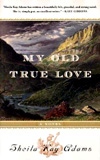




 |
 |
History Comes Alive
The people of Appalachia tell unforgettable stories
by Jeanne McDonald
Say the word “Appalachia” and many people conjure up images of illiterate hillbillies speaking fractured English and living in poverty and ignorance. Some of those assumptions are still valid in parts of the region, but geologists believe that the boundaries of Appalachia extend much farther than common knowledge presupposes: from Stone Mountain, Ga., to the Gaspe Peninsula in Canada, and beyond that, beneath the ocean to Greenland or Ireland, a discovery that explains the strong Celtic influence on regional language. This broader definition labels millions more of us as Appalachians, even some New Yorkers, who might owe writer Lee Smith an apology.
Smith, born in 1944 in Grundy, Va., smack in central Appalachia, tells the story of a reading she gave at Columbia University during her first book tour. “As soon as I opened my mouth,” she recalls, “half the audience got up and walked out.” Presumably, the audience considered Smith a hillbilly simply because of the way she talked. Little did they know that she would become one of the first progenitors to bring Appalachian stories into the American literary mainstream.
Such prejudice still exists about the South and Appalachia, yet there is widespread interest in the area and its rich, romantic history. Two new novels just released by Algonquin are examples of that heritage. Sheila Kay Adams’ book, My Old True Love, ($23.95), is based on the oral history of her own family and interlaced with dozens of old songs.
Adams has been called one of the top five storytellers in the country and has served as technical director for the movie, Songcatcher, and as consultant for  The Last of the Mohicans. Her novel tells the story of the Stantons and the Nortons, families from the British Isles who settled in Sodom, N.C., in the 1700s. It also relates the lifelong competition between cousins Hackley and Larkin, through their involvement in the Civil War and their mutual love for the beautiful Mary Chandler. Hackley Norton, Sheila Adams’s grandfather’s uncle, actually died in the Battle of Winding Stairs in June of 1864 and is portrayed in the book as an irresistible bad boy, prone to fist fighting and womanizing. “Every time Hackley got called on to lead a hymn,” says Arty, “the tenors, which was where all the young girls was setting, would go all a-twitter.... He held himself all loose and easy and his eyes looked lazy and quick at the same time. Even some of the older women set into fanning themselves.” The Last of the Mohicans. Her novel tells the story of the Stantons and the Nortons, families from the British Isles who settled in Sodom, N.C., in the 1700s. It also relates the lifelong competition between cousins Hackley and Larkin, through their involvement in the Civil War and their mutual love for the beautiful Mary Chandler. Hackley Norton, Sheila Adams’s grandfather’s uncle, actually died in the Battle of Winding Stairs in June of 1864 and is portrayed in the book as an irresistible bad boy, prone to fist fighting and womanizing. “Every time Hackley got called on to lead a hymn,” says Arty, “the tenors, which was where all the young girls was setting, would go all a-twitter.... He held himself all loose and easy and his eyes looked lazy and quick at the same time. Even some of the older women set into fanning themselves.”
Larkin Stanton, Hackley’s cousin, is painted as a brooding, mysterious character whose dark secret eventually drives him apart from his beloved family. When Larkin’s mother dies in childbirth, it is left up to his cousin Arty to take care of him. “From the day he was born,” says Arty, “my arms carried him, but that very day was when my heart claimed him for my own.” The real Larkin’s grave can be found at Walnut, N.C., and Arty is buried on a hilltop in Sodom.
Arty narrates the story in the colorful dialect of the mountains, which Adams recreates so effortlessly that long after the last page has been read, the reader still hears her lyrical and rhythmic language reverberating as music in the memory.
Another Appalachian author, Silas House, has accomplished the miraculous feat of writing three literary novels in four years. The latest of these three related books, The Coal Tattoo ($24.95) might be his most accomplished yet. It is the story of two Appalachian sisters whose father is killed in a mining accident. Their mother, inconsolable, kills herself, leaving Easter, 16, to take care of 11-year-old Anneth. Her younger sister’s wild streak is a constant worry for Easter, a devoted Pentecostal, and their connection is temporarily broken when Anneth elopes with a man she barely knows.
A coal tattoo, the term applied to miners who survive the collapse of a mine and emerge with a greenish-blue imprint on their skins, becomes a symbol for endurance and sacrifice, qualities exhibited in this book by many of the citizens of Black Banks, Ky., especially Anneth. House tells his story in modern language, but there is a poetic rhythm to his prose as well. As in Adams’ book, the land is central to the plot, because all the characters are inextricably bound up in family roots and allegiance to the places where their families began repeating the stories and singing the songs that represent their very history.
Larry Brown, an Appalachian writer himself, says of House’s characters, “These are decent, hardworking, generous people, and I’m glad House is telling their stories.” So are we, the readers, who are gladly swept back into the history of places and events that might otherwise be forgotten. As Arty reminisces in the last chapter of Adams’s novel, “It ain’t always been easy, but Lord it has been worth it.”

November 24, 2004 • Vol. 14, No. 48
© 2004 Metro Pulse
|
|